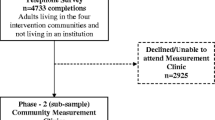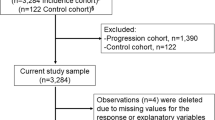Summary
Osteoarthritis has a major impact on mobility and functioning leading to impairment in activities of daily living and quality of life. The aim of our analysis was to reveal the prevalence of self-reported, doctor-diagnosed osteoarthritis with a representative population based survey, including data for 15,474 subjects. Prevalence of osteoarthritis was 11.9 % in men and 18.6 % in women. A total of 73.4 % of men and 74.9 % of women with osteoarthritis reported to have had severe pain in the last 12 months; 60.3 % of male and 67.0 % of female patients reported that the disease was treated within the last 12 months. Age, socio-economic parameters, overweight and obesity, as well as living in a rural area were significant predictors of osteoarthritis. Even if the onset of osteoarthritis may not be averted, public health and prevention programmes may improve quality of life significantly if they are adequately tuned to sex, age and personal capabilities.
Zusammenfassung
Arthrosen haben eine enorme Auswirkung auf die Mobilität und Funktionsfähigkeit und führen zu Einbußen in den Aktivitäten des täglichen Lebens und der Lebensqualität. Es war die Absicht unserer Analyse, die Prävalenz von selbstberichteten ärztlich diagnostizierten Arthrosen mittels einer repräsentativen bevölkerungsbasierten Studie mit einem Umfang von 15.474 Personen zu ermitteln. Die Arthroseprävalenz betrug 11,9 % bei Männern und 18,6 % bei Frauen. 73,4 % der betroffenen Männer und 74,9 % der Frauen berichteten über erhebliche Schmerzen in den letzten 12 Monaten. 60,3 % der männlichen und 67,0 % der weiblichen ArthrosepatientInnen berichteten, dass die Erkrankung in dieser Zeit behandelt wurde. Alter, sozio-ökonomische Parameter, Übergewicht und Adipositas sowie eine ländliche Wohnregion waren Prädiktoren für Arthrosen. Obwohl der Ausbruch einer Arthrose üblicherweise nicht verhindert werden kann, könnten Public Health- und Präventionsprogramme die Lebensqualität deutlich verbessern, wenn sie Geschlechts- und Altersaspekte sowie das persönliche Potential adäquat berücksichtigen.



Similar content being viewed by others
References
Brooks PM. Impact of osteoarthritis on individuals and society: how much disability? Social consequences and health economic implications. Curr Opin Rheumatol. 2002;14:573–7.
Felson DT, Zhang Y. An update on the epidemiology of knee and hip osteoarthritis with a view to prevention. Arthritis Rheum. 1998;41:1343–55.
World Health Organization. Bone and Joint Decade’s Musculoskeletal Portal. http://www.boneandjointdecade.org (2012) Accessed 10 Sept 2012.
Dorner T, Weichselbaum E, Lawrence K, et al. Austrian Osteoporosis Report: epidemiology, lifestyle factors, public health strategies. Wien Med Wochenschr. 2009;159:221–9.
Choong P, Brooks P. Achievements during the Bone and Joint Decade 2000–2010. Best Pract Res Clin Rheumatol. 2012;26:173–81.
Busija L, Bridgett L, Williams SR, et al. Osteoarthritis. Best Pract Res Clin Rheumatol. 2010;24:757–68.
Carmona L, Ballina J, Gabriel R, et al.; EPISER Study Group. The burden of musculoskeletal diseases in the general population of Spain: results from a national survey. Ann Rheum Dis. 2001;60:1040–5.
Statistik Austria Herausgeber. Im Auftrag von Bundesministerium für Gesundheit, Familie und Jugend. Österreichische Gesundheitsbefragung 2006/07. Hauptergebnisse und methodische Dokumentation. Wien 2007.
Aromaa A, Koponen P, Tafforeau J, et al. Evaluation of health interview surveys and health examination surveys in the European Union. Eur J Public Health. 2003;13(3 Suppl):67–72.
Murphy B, Herrman H, Hawthorne G, et al. Australian WHOQoL instruments: user’s manual and interpretation guide. Melbourne, Australia: Australian WHOQoL Field Study Centre; 2000.
Group TW. Development of the World Health Organization WHOQOL-BREF quality of life assessment. Psychol Med. 1998;28:551–8.
Angermeyer MC, Kilian R, Matschinger H. WHOQOL-100 und WHOQOL-BREF. Handbuch für die deutsche Version der WHO Instrumente zur Erfassung von Lebensqualität. Göttingen: Hogrefe; 2000.
Grotle M, Hagen KB, Natvig B, et al. Prevalence and burden of osteoarthritis: results from a population survey in Norway. J Rheumatol. 2008;35:677–84.
Calza S, Decarli A, Ferraroni M. Obesity and prevalence of chronic diseases in the 1999–2000 Italian National Health Survey. BMC Public Health. 2008;8:140.
Hanna FS, Wluka AE, Bell RJ, et al. Osteoarthritis and the postmenopausal woman: epidemiological, magnetic resonance imaging, and radiological findings. Semin Arthritis Rheum. 2004;34:631–6.
Pietschmann P. Sex differences in joint diseases: pathophysiological basis. Wien Med Wochenschr. 2001;151:573–5.
Dorner TE, Muckenhuber J, Stronegger WJ, et al. The impact of socio-economic status on pain and the perception of disability due to pain. Eur J Pain. 2011;15:103–9.
Felson DT, Hannan MT, Naimark A, et al. Occupational physical demands, knee bending, and knee osteoarthritis: results from the Framingham Study. J Rheumatol. 1991;18:1587–92.
Hunter DJ, March L, Sambrook PN. Knee osteoarthritis: the influence of environmental factors. Clin Exp Rheumatol. 2002;20:93–100.
Aggarwal VR, Macfarlane TV, Macfarlane GJ. Why is pain more common amongst people living in areas of low socio-economic status? A population-based cross-sectional study. Br Dent J. 2003;194:383–7.
Macfarlane GJ, Norrie G, Atherton K, et al. The influence of socioeconomic status on the reporting of regional and widespread musculoskeletal pain: results from the 1958 British Birth Cohort Study. Ann Rheum Dis. 2009;68:1591–5.
Felson DT, Anderson JJ, Naimark A, et al. Obesity and knee osteoarthritis. The Framingham Study. Ann Intern Med. 1988;109:18–24.
Hart DJ, Doyle DV, Spector TD. Incidence and risk factors for radiographic knee osteoarthritis in middle-aged women: the Chingford Study. Arthritis Rheum. 1999;42:17–24.
Jiang L, Tian W, Wang Y, et al. Body mass index and susceptibility to knee osteoarthritis: a systematic review and meta-analysis. Joint Bone Spine. 2012;79:291–7.
Felson DT, Zhang Y, Hannan MT, et al. Risk factors for incident radiographic knee osteoarthritis in the elderly: the Framingham Study. Arthritis Rheum. 1997;40:728–33.
Schouten JS, Van Den Ouweland FA, Valkenburg HA. A 12 year follow up study in the general population on prognostic factors of cartilage loss in osteoarthritis of the knee. Ann Rheum Dis. 1992;51:932–7.
Jahelka B, Dorner T, Terkula R, et al. Health-related quality of life in patients with osteopenia or osteoporosis with and without fractures in a geriatric rehabilitation department. Wien Med Wochenschr. 2009;159:235–40.
Pieber K, Stein KV, Herceg M, et al. Determinants of satisfaction with individual health in male and female patients with chronic low back pain. J Rehabil Med. 2012;44:658–63.
Norimatsu T, Osaki M, Tomita M, et al. Factors predicting health-related quality of life in knee osteoarthritis among community-dwelling women in Japan: the Hizen-Oshima study. Orthopedics. 2011;34:e535–40.
Muraki S, Akune T, Oka H, et al. Health-related quality of life in subjects with low back pain and knee pain in a population-based cohort study of Japanese men: the research on osteoarthritis against disability study. Spine (Phila Pa 1976). 2011;36:1312–9.
Michon M, Maheu E, Berenbaum F. Assessing health-related quality of life in hand osteoarthritis: a literature review. Ann Rheum Dis. 2011;70:921–8.
Stamm TA, Machold K, Sahinbegovic E, et al. Daily functioning and health status in patients with hand osteoarthritis: fewer differences between women and men than expected. Wien Klin Wochenschr. 2011;123:603–6.
Baird CL. Living with hurting and difficulty doing: older women with osteoarthritis. Clin Excell Nurse Pract. 2000;4:231–7.
Elbaz A, Debbi EM, Segal G, et al. Sex and body mass index correlate with Western Ontario and McMaster Universities Osteoarthritis Index and quality of life scores in knee osteoarthritis. Arch Phys Med Rehabil. 2011;92:1618–23.
Jakobsson U, Hallberg IR. Pain and quality of life among older people with rheumatoid arthritis and/or osteoarthritis: a literature review. J Clin Nurs. 2002;11:430–43.
Conflict of interest
The authors declare that there is no conflict of interest.
Author information
Authors and Affiliations
Corresponding author
Rights and permissions
About this article
Cite this article
Dorner, T., Stein, K. Prevalence and status quo of osteoarthritis in Austria. Analysis of epidemiological and social determinants of health in a representative cross-sectional survey. Wien Med Wochenschr 163, 206–211 (2013). https://doi.org/10.1007/s10354-013-0174-8
Received:
Accepted:
Published:
Issue Date:
DOI: https://doi.org/10.1007/s10354-013-0174-8




